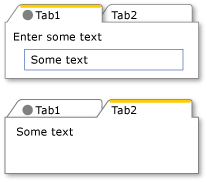HeaderedContentControl.Header Property
Definition
Important
Some information relates to prerelease product that may be substantially modified before it’s released. Microsoft makes no warranties, express or implied, with respect to the information provided here.
Gets or sets the data used for the header of each control.
public:
property System::Object ^ Header { System::Object ^ get(); void set(System::Object ^ value); };[System.ComponentModel.Bindable(true)]
[System.Windows.Localizability(System.Windows.LocalizationCategory.Label)]
public object Header { get; set; }[<System.ComponentModel.Bindable(true)>]
[<System.Windows.Localizability(System.Windows.LocalizationCategory.Label)>]
member this.Header : obj with get, setPublic Property Header As ObjectProperty Value
A header object. The default is null.
- Attributes
Examples
The following example creates a TabControl that contains two TabItem objects, which inherit from HeaderedContentControl. The first TabItem has UIElement objects as the content in both the Header and the Content: the Header is set to a StackPanel that contains an Ellipse and a TextBlock; the Content is set to a StackPanel that contains a TextBlock and a Label. The Header of the second TabItem is set to a string and the Content is set to a single TextBlock.
<TabControl>
<TabItem>
<TabItem.Header>
<StackPanel Orientation="Horizontal">
<Ellipse Width="10" Height="10" Fill="DarkGray"/>
<TextBlock>Tab 1</TextBlock>
</StackPanel>
</TabItem.Header>
<StackPanel>
<TextBlock>Enter some text</TextBlock>
<TextBox Name="textBox1" Width="50"/>
</StackPanel>
</TabItem>
<TabItem Header="Tab 2">
<!--Bind TextBlock.Text to the TextBox on the first
TabItem.-->
<TextBlock Text="{Binding ElementName=textBox1, Path=Text}"/>
</TabItem>
</TabControl>
The following illustration shows the TabControl created by the previous example.
 TabControl with different types in the Header property
TabControl with different types in the Header property
The following example creates two DataTemplate objects to specify the appearance of the Header and Content of the HeaderedContentControl.
<Style TargetType="HeaderedContentControl">
<Setter Property="Template">
<Setter.Value>
<ControlTemplate TargetType="{x:Type HeaderedContentControl}">
<StackPanel>
<Grid>
<Rectangle Stroke="{TemplateBinding Background}"/>
<ContentPresenter ContentSource="Header"/>
</Grid>
<Grid>
<Rectangle Fill="{TemplateBinding Background}"/>
<ContentPresenter ContentSource="Content"/>
</Grid>
</StackPanel>
</ControlTemplate>
</Setter.Value>
</Setter>
</Style>
<DataTemplate x:Key="titleText">
<TextBlock Text="{Binding}"
Foreground="Green"
FontSize="16"
FontWeight="Normal"
FontStyle="Italic"
TextWrapping="Wrap"/>
</DataTemplate>
<DataTemplate x:Key="contentText">
<TextBlock Text="{Binding}"
Foreground="Brown"
FontSize="12"
FontWeight="Normal"
FontFamily="Arial Narrow"
TextWrapping="Wrap"/>
</DataTemplate>
<HeaderedContentControl Name="hcontCtrl" Background="Beige"
HeaderTemplate="{StaticResource titleText}"
ContentTemplate="{StaticResource contentText}"
Header="This is the header."
Content="This is the content."/>
Remarks
Like the Content property of a ContentControl, the Header can be any type. The HeaderedContentControl uses the same logic to display the Header that is described in ContentControl.Content.
Dependency Property Information
| Item | Value |
|---|---|
| Identifier field | HeaderProperty |
Metadata properties set to true |
None |
